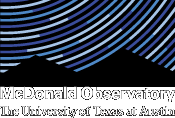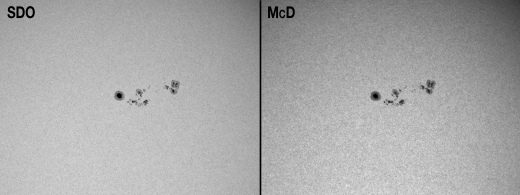McDonald Shines on Solar Viewing Upgrades
by Frank Cianciolo
This video of a solar flare was taken on Oct. 14, 2015 at McDonald Observatory using a six-inch telescope with a hydrogen alpha filter. (Kevin Mace/McDonald Observatory)
If someone mentions viewing the Sun, what first comes to your mind? Wearing a cardboard box over your head looking at a tiny pinhole-projected image? Viewing the photosphere with a white-light filter mounted at the front of your telescope? Stunning images from space-based solar telescopes? If your first thought wasn’t the Solar Viewing at McDonald Observatory, you just might be in for a treat.
It wasn’t that long ago that our white-light views showed mostly featureless sunspots, and the rest of the surface looked mostly blank white. However, images taken from McDonald Observatory’s Solar Viewing system now show an amazing level of detail — comparable to images taken by the Solar Dynamics Observatory (SDO) from space — despite being taken through the Earth’s atmosphere.
The most recent upgrades to the Solar Viewing system have advanced the Frank N. Bash Visitors Center (VC) solar imaging capabilities to a point not dreamed of even three or four years ago, much less 14 years ago when the VC opened. While the Visitors Center is most well known for the nighttime views afforded during well-attended evening Star Parties at the Helen S. Martin Star Amphitheater and the Rebecca Louise Gale Telescope Park, the excellent twice-daily “Solar Viewings” of our nearest star are not to be missed.
McDonald Observatory has been hosting Solar Viewings since the W. L. Moody, Jr. Center opened its doors in 1981. Early programs consisted of projecting an image of the photosphere through an 8-inch Celestron Schmidt-Cass onto an approximately 8-inch paper screen with a staff member commenting on any visible sunspots. In the early ‘90s, the Moody Center acquired a Hydrogen-alpha (Hα) filter, which allowed routine viewing of sunspots, prominences, spicules, and occasional flares if you knew what to look for and if you knew how to navigate a relatively dim red image while surrounded by bright sunlight. Typical visitors were mostly lost.
Then, longtime friend and Houston amateur astronomer Lloyd Overcash made a gift of an off-the-shelf video surveillance camera and sundry adapters. Soon, Solar Viewing participants were treated to live views of impressive chromospheric features easily seen by all on bright television screens. There were still a few drawbacks, however. In addition to visitors needing to stand uncomfortably throughout the program, sunlight streaming through the dome shutter frequently caused bright glare on the television screens or, worse, in the eyes of those unfortunate enough to have to stand in the opening. Also, the setup offered only one rather highly magnified view.
With the construction of the Frank N. Bash Visitors Center (VC) and its multimedia theater, new possibilities presented themselves. 2016 Board of Visitors Staff Excellence Award winner Kevin Mace was just the person to bring those possibilities to life. Fiber optic cables and video converters brought live views from a pair of telescopes — one Hα filtered, the other white-light filtered — into the VC’s 12-foot wide screen. The telescopes could be remotely controlled, with animations, time-lapse video, and access to the latest images available online. Best of all, participants could sit comfortably in the theater out of the glare of the Texas sun. Except...
Those live images that had looked fine on 21-inch tube-type TV screens were now seen to be somewhat lacking when enlarged to fit a 12-foot screen. Mace began a quest for better video cameras and has continued to equip the Solar Viewing system with the latest and best equipment possible. Early donations from the Semmes Foundation helped the VC procure higher-resolution remote-controlled cameras that allowed far better viewing of various solar features. Later donations, also from the Semmes Foundation, added a wide-field “full disk” Hα view to contrast with the existing “full disk” white-light, and more highly magnified Hα views.
Las Cumbres Observatory founder Wayne Rosing’s keen eye for optics noticed that the 14-inch Celestron Schmidt-Cass telescope providing the main Hα view could be improved, and he generously offered to replace the Celestron with a 6-inch AstroPhysics refractor, donated a 4-inch StarLight refractor to provide a detailed white-light view, and even provided a new pier designed and fabricated specifically for the VC’s use with the new refractors. Now the cameras, so appreciated just a number of years before for their enhanced views, needed replacement! Once again, the Semmes Foundation stepped up. After these most recent upgrades, Rosing stated, “The McDonald image is just about the best I have seen. Clearly Mt Locke has excellent morning seeing, which is often the key for great solar observing. I am very pleased to see first hand the quality of the images produced by the telescope we donated.”
The Visitors Center, always a work in progress, will no doubt continue to add improvements to its Solar Viewing system, through generous supporters and through income generated by the VC’s dramatically growing visitation. The daytime Solar Viewing is often the most inspiring and hands-on experience gained by students who visit McDonald Observatory on day trips from local rural areas, and these programs are a very important part of the education and outreach mission.
On a recent afternoon visit to the Visitors Center, Board of Visitors member and Fort Davis resident Van Robinson was able to inspect the entire setup from front-end glass to video screen output, and every part in between. “The system Mr. Mace has masterfully assembled with the help of interested Board of Visitors members and other donors would certainly be the envy of the most advanced amateur astronomer and even, I suspect, a few solar researchers," he said. "The full-disk white-light images Kevin frequently generates with the setup rival those posted on NASA’s Solar Dynamics Observatory website. That all this was done to allow the public to see and learn about our Sun is just one of the many things that makes McDonald Observatory such a special place.”
Other images from McDonald Observatory solar viewing system are: comparison of three cameras; comparison of old and new Semmes cameras; sunspots, flares and filaments; solar prominence. Other available videos: quiescent solar prominence; eruptive solar prominence.


